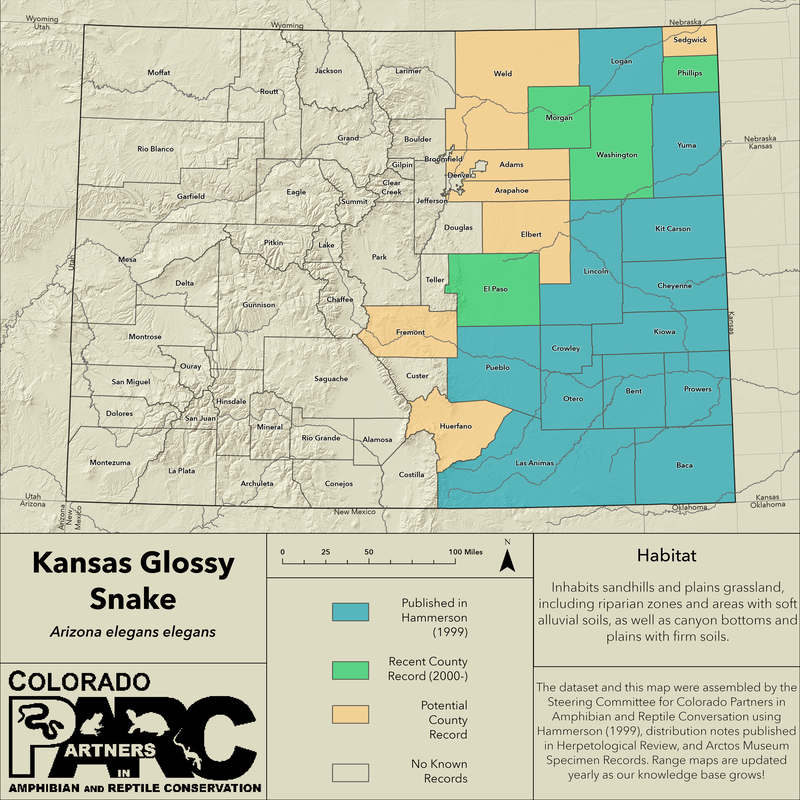Kansas glossy snakeArizona elegans elegans
NON-VENOMOUS |
Identification
- An overall slender species
- Brown or grey, black-edged blotches run down the back
- Overall body color is relatively pale; can range from tan, yellowish gray, or cream to pinkish
- The venter is usually plain white to cream in color or very light brown
- The pupil is slightly vertically elliptical (oval).
- Smooth and shiny dorsal scales (not keeled).
- Has a dark oblique stripe extending back from orbit (forehead) to the corner of the mouth
Size: The Glossy Snake can grow to a maximum total body length (TBL) of 177.8 cm, but most individuals are under 100 cm in length. Males are shorter than females and have tail lengths (TL) that represent 13-17% of their bodies. Female TL can represent 12-15% of their bodies. Hatchlings average 24.8 cm in TBL (Ernst & Ernst 2003).
Distribution: The Glossy Snake occurs below 5,000 feet in eastern and extreme southwestern Colorado (Hammerson, 1999). The Glossy Snake occurs in central Texas, Nebraska, and eastern and southwestern Colorado, southern Utah, southern Nevada, and the San Joaquin Valley of California south into Mexico (Ernst and Ernst, 2003).
Habitat: A. elegans lives in a variety of habitats that have sandy or loamy soils with or without rocks present. Such habitats include; deserts with thorn scrub, creosote-mesquite patches, chaparral, sagebrush, grasslands, and oak-hickory woodlands at elevations that range from below sea level to about 2,200 meters (insert citation).
Activity: The daily activity of the Glossy Snake is crepuscular and nocturnal. Glossy Snakes rarely are active during the day (Ernst & Ernst 2003). The slightly vertically elliptical pupil that this species has is an adaptation for night vision, along with its retina, which has both cones and rods (Stebbins 2003). Annually, A. elegans is active in Colorado from May to October; in Southern California, Arizona, and New Mexico, activity has been observed from late February or early March until November (Hammerson 1999). Most of the Glossy Snake’s surface activity takes place between the months of May, June, and July. During winter, the Glossy Snake hibernates underground in a mammal burrow or buried into soil below the frost line (Hammerson 1999). If buried, the Glossy Snake may occasionally come up to the surface to bask on warm, sunny, winter days.
Conservation Status: Designated as a Non-game Species in Colorado. Please click here for State of Colorado regulations regarding this species. The Speckled Kingsnake has a global status of G5 (globally secure) and a state status in Colorado of S3/S4 (state 'apparently secure / vulnerable'; NatureServe). The Glossy Snake is highly secretive and this factor makes it difficult to assess its current conservation status, distribution, and abundance. Habitat loss through conversion of native range to agricultural areas no doubt has resulted in at least localized population declines, although in some areas, such as Otero County, this species is found regularly (Hammerson 1999). The apparent rarity of this species may be due to its nocturnal and crepuscular habits. Most Glossy Snakes are encountered on roads, and the majority of these observations are of individuals killed by traffic (Hammerson, 1999).
Reproduction: Usually in 3 to 4 years female Glossy Snakes have reached a snout vent length (SVL) of >50 cm and TBLs of 66 cm. At this point, specimens of this species are reported to have viable eggs (Ernst & Ernst 2003). The minimum length of mature males has not been reported. Not all females will produce eggs annually. In fact, 33% are not reproductively ready each year. Courtship and mating happens in April to June for this species and eggs are laid from late May through July (Stebbins 2003). Glossy Snake clutches contain 3 to 24 eggs that are white and have leathery, flexible shells. Hatchlings begin to appear starting late August and continue through September (Ernst & Ernst, 2003).
Feeding & Diet: A. elegans actively seeks out its prey both underground and on the surface by using its vision and by scent. The Glossy Snake will make an effort to chase its prey and if close enough, seize it immediately. The primary food of the Glossy Snake consists of lizards and small rodents (insert citation). Small mammals are quickly swallowed but if a Glossy Snake has caught a larger mammal, it will first constrict it. Other small mammals reported in the Glossy Snake diet include: pocket mice, kangaroo rats, white-footed mice, and moles. Small birds, small snakes, and insects (Ernst & Ernst 2003).
Defenses from Predation: Predators of the Glossy Snake most likely include carnivorous mammals, raptors, and larger snakes; however, published records are rare. To deter predators, A. elegans will vibrate its tail when approached and if handled, spray musk (Ernst and Ernst, 2003). Many Glossy Snakes are killed on roads or from the effects of agriculture and habitat destruction (Hammerson, 1999).
Cited & Additional Resources
Ernst, C. H., and E. M. Ernst. 2003. Snakes of the United States and Canada. Simthsonian Books, Wsahington and London. 77 pp.
Hammerson G. A. 1999. Amphibians and reptiles in Colorado. 2nd ed. University Press of Colorado, Boulder, Colorado. 292 pp.
Stebbins, R. C. 2003. Western reptiles and amphibians. 3rd ed. Houghton Mifflin Company, New York, New York. 351 pp.
Hammerson G. A. 1999. Amphibians and reptiles in Colorado. 2nd ed. University Press of Colorado, Boulder, Colorado. 292 pp.
Stebbins, R. C. 2003. Western reptiles and amphibians. 3rd ed. Houghton Mifflin Company, New York, New York. 351 pp.
Account compiled by: Beth Wittmann
Reviewed by: Lauren Livo & Danny Martin (text)
Last updated: 4/14/2022 by Rémi Pattyn
Reviewed by: Lauren Livo & Danny Martin (text)
Last updated: 4/14/2022 by Rémi Pattyn
Suggested Citation
Colorado Partners in Amphibian and Reptile Conservation. 2015. Species account for Glossy Snake (Arizona elegans). Compiled by Beth Wittmann. http://www.coparc.org/glossy-snake.html [accessed date here]. Editors: Lauren Livo & Danny Martin.
Colorado Partners in Amphibian and Reptile Conservation. 2015. Species account for Glossy Snake (Arizona elegans). Compiled by Beth Wittmann. http://www.coparc.org/glossy-snake.html [accessed date here]. Editors: Lauren Livo & Danny Martin.


